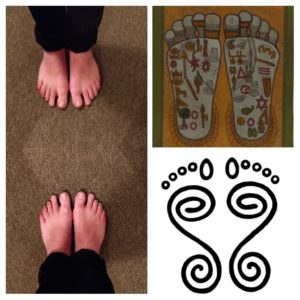Over the years and especially with the practice of Yoga I’ve become more aware of anything that causes discomfort, this is a basic premise in Yoga, the movement from dukkha, discomfort to sukha, comfort. I had noticed over recent years that even though I was usually wearing quality walking shoes, just how confining to my feet they felt. Since I was young I’d always found being barefoot to be very comfortable, I frequently went walking over the fields in bare feet and marvelled at how much it positively influenced the entire body and mind.
I first became aware of barefoot/minimalist shoes about a year ago, and bought my first pair in the autumn, becoming hooked almost instantly. The main characteristics of minimalist shoes are a broad toe box so that the foot and toes can spread, a “zero drop heel” whereby the foot remains flat and usually a lightweight construction and flexible sole. These all combine to create a unique experience.
Even though I’ve always enjoyed walking, the first few times I wore them, it did feel like being barefoot, I became incredibly aware of each step, the ground, and my whole gait and physical structure began being transformed by them. Their wear makes me feel even more alive, sense wise the feet delight in the feel of the ground, especially different terrains and surfaces, my body feels much lighter and energised so that walking feels effortless, while the mind becomes even clearer and brighter. With more wear I’ve found a lot of my older footwear difficult to return to as daily wear and have subsequently been doing quite a bit of eBay selling!
Looking at the history of what we know now as modern shoes, we find that many of their key features are relatively recent phenomena. Examining why they ended up with heels, it apparently originates with European aristocracy a few centuries ago, being taken by the footwear of Persian cavalrymen in the 16th century, which had heels to help keep their feet in their stirrups. They first became popular with men then women. The narrow shape also arose from what was perceived as fashionable, while rigid soles are an over enthusiastic attempt to protect the foot, which ironically limits it’s free movement.
It’s easy to understand the effect of this on our musculoskeletal system via raised heels, especially on the spine and also the more subtle effect on the muscles of the foot and the nervous system through a narrow toe box and rigid sole. If it has this effect on the body and nervous system, what effect is it having on the mind?
So we find that in this case a few historical quirks spread across the globe and influence all of us in the present. This is a fundamental recognition of yoga, regarding how the influence of the past, it’s thinking, experiences and occurrences shapes the present world and ourselves.
In a case like shoes, we have features in them, which at best don’t serve us well and at worst are causing us damage. If we think of what we have inherited from the past, we can easily recognise that our beliefs, thinking patterns, culture, etc have all evolved from what has preceded us. History, society and culture is passed on, sometimes we perpetuate this past without the recognition of it’s influence upon ourselves.
While I’m not advocating that just because you’ve read this you should change your footwear, what I do believe is important, is an examination or exploration of all aspects of life, especially those we feel may be making us uncomfortable or inhibiting us. Socrates said the unexamined life is not worth living, and most definitely an examination of life makes living it more pleasant, healthier and enjoyable. Even a basic Hatha Yoga practice initiates this, it’s almost impossible to do a few Yoga postures without noticing what is happening in your body, this is often likened to an unfolding of awareness which inevitably continues on it’s own, guiding us from Dukkha to Sukha.




